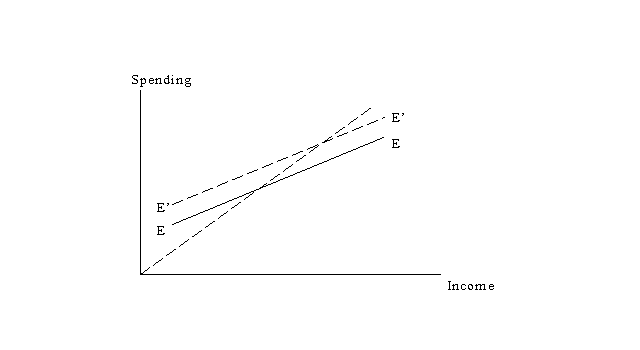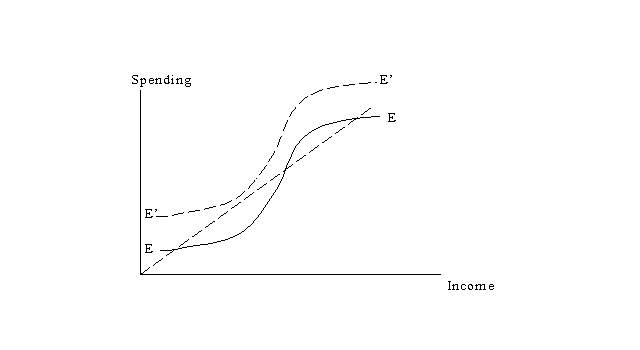
SYNOPSIS: The Japanese policy of heavy fiscal spending to generate a Self-Sustaining Economic boom is silly and will lead to larger problems in the long run.
Japan is currently engaged in the largest peacetime fiscal stimulus in history, with a budget deficit of around 10 percent of GDP. And this stimulus is working in the narrow sense that it has headed off the imminent risk of a deflationary spiral, and generated some economic growth. On the other hand, deficits this size cannot be continued over the long haul; Japan now has Italian (or Belgian) levels of internal debt, together with large implicit liabilities associated with its awkward demographics. So the current strategy can work in the larger sense only if it succeeds in jump-starting the economy, in eventually generating a self-sustaining recovery that persists even after the stimulus is phased out.
Is this likely? The phrase "self-sustaining recovery" trips lightly off the tongue of economic officials; but it is in fact a remarkably exotic idea. The purpose of this note is to expose this hidden exoticism - to show that anyone who believes that temporary fiscal stimulus will produce sustained recovery is implicitly endorsing a rather fancy economic model, the sort of model that finance ministries would under normal circumstances regard as implausible and disreputable.
As a starting point for this discussion, we should notice that Japan has unwittingly managed to turn itself into an old-fashioned Keynesian economy, the sort of economy envisioned in the original, 1948 edition of Samuelson's textbook. With large excess capacity, Japan is unmistakably constrained by demand rather than supply; with call money rates hard up against zero, Japan has the fixed interest rate assumed in naive multiplier analysis. So leaving aside foreign trade and the exchange rate (which really do not change the fundamental picture - see my discussion in Japan: still trapped), Japan's economy can be pictured using the good old "Keynesian cross" (also known as a Samuelson cross) depicted in Figure 1 .
The figure graphs the economy's total income - GDP - against its total spending. The equilibrium level of output is determined by two conditions. First, income must equal spending: hence the 45-degree line where income equals spending. Second, spending itself depends positively on income, as represented by the upward-sloping line EE. In Figure 1 I have followed the textbook convention of assuming that a dollar of additional income raises spending by less than a dollar (sorry, 104 yen raise spending by less than ...), so that EE is flatter than the 45-degree line, and there is a unique equilibrium level of output.
In this conventional picture, deficit spending can raise EE, say to E'E', and thereby expand the economy. But if the deficits are unsustainable, this is only a temporary solution. Eventually the stimulus must be scaled back, and EE will shift back down; the economy will be back in slump. (You might think of this as a potted history of the Hashimoto fiasco).
When, then, can fiscal stimulus work as a long-run solution? There seem to be two possible answers. The first is that deficit spending can serve as a bridge over troubled waters. Suppose that the factors depressing private spending are clearly temporary - for example, there is a clearly temporary financial crisis underway, or investment is on hold pending some sort of financial cleanup, etc.. That is, there are good reasons to think that EE will shift up in the not-too-distant future in any case; so propping it up artificially with fiscal stimulus is simply a holding action until the cavalry arrives.
It's actually hard to come up with good examples of this kind of fiscal program - maybe Sweden's efforts to ride out the first oil shock in the mid-70s. In the case of Japan, a starry-eyed optimist might argue that restructuring of Japanese banks and corporations will eventually create a "new economy" that generates a lot of investment. A more likely scenario, however, is that the prolonged process of restructuring will keep consumers nervous and if anything depress demand. That cavalry may be a long time in coming.
Anyway, Japanese officials seem to have something more in mind than waiting for good news to arrive. Their idea is that the massive stimulus now underway will not need to be continued, because it will generate that "self-sustaining recovery". What would the Keynesian cross have to look like for that view to be justified?
The answer is that it would have to look like Figure 2 . Over some range increases in income would have to raise spending more than one-for-one, so that there would be multiple equilibrium levels of income. Of the three equilibria illustrated in Figure 2, the middle one will be unstable under any plausible adjustment story, so there will be two interesting possibilities: a high-level equilibrium (perhaps at above-full-employment output, so that it would allow interest rates to be raised off the floor and normal monetary policy to resume), and a low-level trap. A sufficiently large fiscal stimulus, then, would push EE up to E'E', and hence jolt the economy out of the low level trap. If sustained long enough, it would generate favorable expectations by the private sector, so that when the stimulus is removed and EE drops back to its original position the economy will end up in the high-level equilibrium, not fall back into depression.
Do you believe this picture? There is nothing wrong with multiple equilibrium stories in macroeconomics; indeed, sometimes they seem to be the only way to make sense of events. Just a few days ago I cheerfully used a diagram not too different from this one to make sense of the Asian financial crisis ( Analytical afterthoughts on the Asian crisis ). But anyone who has played this sort of analytical game knows that multiple equilibria are something to be invoked only sparingly: as William of Ockham might have said, thou shalt not multiply equilibria unnecessarily. The point is that multiple equilibria are too easy - they are a device that can justify practically any policy, and should therefore not be proposed unless you have some compelling reason to think they must be there.
Now you could argue that the experience of the Depression and after provides just such evidence. Many economists thought that with the end of World War II spending the United States would revert to Depression-type conditions; a whole school of thought, the "secular stagnation" hypothesis, was built around that idea. In fact, once jolted out of depression, the U.S. did not fall back; one explanation is a story something like that in Figure 2.
But it is quite a stretch to argue that Japan in the 90s is a parallel case. It might be; but an at least equally, if not more, plausible story is that Japan has a structural excess of saving over investment, even at a zero interest rate; in that case a temporary fiscal stimulus will produce only temporary results.
What continues to amaze me is this: Japan's current strategy of massive, unsustainable deficit spending in the hopes that this will somehow generate a self-sustained recovery is currently regarded as the orthodox, sensible thing to do - even though it can be justified only by exotic stories about multiple equilibria, the sort of thing you would imagine only a professor could believe. Meanwhile further steps on monetary policy - the sort of thing you would advocate if you believed in a more conventional, boring model, one in which the problem is simply a question of the savings-investment balance - are rejected as dangerously radical and unbecoming of a dignified economy.
Will somebody please explain this to me?

